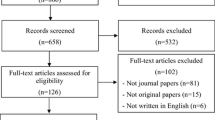Abstract
Fall prediction using machine learning has become one of the most fruitful and socially relevant applications of computer vision in gerontological research. Since its inception in the early 2000s, this subfield has proliferated into a robust body of research underpinned by various machine learning algorithms (including neural networks, support vector machines, and decision trees) as well as statistical modeling approaches (Markov chains, Gaussian mixture models, and hidden Markov models). Furthermore, some advancements have been translated into commercial and clinical practice, with companies in various stages of development capitalizing on the aging population to develop new commercially available products. Yet despite the marvel of modern machine learning-enabled fall prediction, little research has been conducted to shed light on the security and privacy concerns that such systems pose for older adults. The present study employs an interdisciplinary lens in examining privacy issues associated with machine learning fall prediction and exploring the implications of these models in elderly care and the Internet of Medical Things (IoMT). Ultimately, a justice-informed set of best practices rooted in social geroscience is suggested to help fall prediction researchers and companies continue to advance the field while preserving elderly privacy and autonomy.
Similar content being viewed by others
References
Ahonen T, Hadid A, Pietikainen M (2006) Face description with local binary patterns: application to face recognition. IEEE Trans Pattern Anal Mach Intell 28(12):2037–2041
Alazrai R, Mowafi Y, Hamad E, 2015 editors. A fall prediction methodology for elderly based on a depth camera. 2015 37th Annual International Conference of the IEEE Engineering in Medicine and Biology Society (EMBC). Pp. 25–29
Chen Z, Hu W, Wang J, Zhao S, Amos B, Wu G, et al. An empirical study of latency in an emerging class of edge computing applications for wearable cognitive assistance. Proceedings of the Second ACM/IEEE Symposium on Edge Computing. 2017.
Dele. Fall Prevention [cited 2022 Jan 18, 2022]. Available from: https://delehealth.com/solutions/prevention/.
Fabbrini F (2015) Human rights in the digital age: The European Court of Justice ruling in the data retention case and its lessons for privacy and surveillance in the United States. Harv Hum Rights J 28:65–95
Hartmann M, Hashmi US, Imran A (2022) Edge computing in smart health care systems: review, challenges, and research directions. Trans Emerg Telecommun Technol 33(3):e3710
Korshunov P, Ebrahimi T, editors. Using war** for privacy protection in video surveillance. 2013 18th International Conference on Digital Signal Processing (DSP); 2013 1–3 July 2013.
Liu F, Tang G, Li Y, Cai Z, Zhang X, Zhou T (2019) A Survey on edge computing systems and tools. Proc IEEE 107(8):1537–1562
McIntyre TJ (2008) Data retention in Ireland: privacy, policy and proportionality. Comput Law Secur Rev 24(4):326–334
Nakashima Y, Koyama T, Yokoya N, Babaguchi N, editors. Facial expression preserving privacy protection using image melding. 2015 IEEE International Conference on Multimedia and Expo (ICME); 2015 29 June-3 July 2015.
Newton EM, Sweeney L, Malin B (2005) Preserving privacy by de-identifying face images. IEEE Trans Knowl Data Eng 17(2):232–243
Ocuvera. AI technology that empowers nurses to prevent patient falls. [cited 2022 Jan 18, 2022]. Available from: https://ocuvera.com/.
Pannurat N, Thiemjarus S, Nantajeewarawat E (2014) Automatic fall monitoring: a review. Sensors 14(7):12900
Patton M, Gross E, Chinn R, Forbis S, Walker L, Chen H, 2014 editors. Uninvited Connections: A Study of Vulnerable Devices on the Internet of Things (IoT). 2014 IEEE Joint Intelligence and Security Informatics Conference; 2014 24–26
Peterson A. Yes, terrorists could have hacked Dick Cheney's heart: The Washington Post; 2013 [cited 2022 Jan 18, 2022]. Available from: https://www.washingtonpost.com/news/the-switch/wp/2013/10/21/yes-terrorists-could-have-hacked-dick-cheneys-heart/.
Qventus. The Leader in AI-Powered Healthcare Operations [cited 2022 Jan 18, 2022]. Available from: https://qventus.com/.
Rojszczak M (2021) The uncertain future of data retention laws in the EU: Is a legislative reset possible? Comput Law Secur Rev 41:105572
Roshdibenam V, Jogerst GJ, Butler NR, Baek S (2021) Machine learning prediction of fall risk in older adults using timed up and go test kinematics. Sensors 21(10):3481
Scott J. Preventing Seniors From Falling is Going to Be a Huge Market: KQED; 2017 [cited 2022 Jan 18, 2022]. Available from: https://www.kqed.org/futureofyou/435417/dying-from-a-fall-is-top-danger-for-seniors-tech-devices-may-help.
Sixsmith A, Johnson N (2004) A smart sensor to detect the falls of the elderly. IEEE Pervasive Comput 3(2):42–47
Song KS, Nho YH, Kwon DS, 2017 editors. Histogram based fall prediction of patients using a thermal imagery camera. 2017 14th International Conference on Ubiquitous Robots and Ambient Intelligence (URAI); 2017 28 June-1.
Steinke G (2002) Data privacy approaches from US and EU perspectives. Telemat Inform 19(2):193–200
Turk M, Pentland A (1991) Eigenfaces for recognition. J Cogn Neurosci 3(1):71–86
Viola P, Jones M, editors. Rapid object detection using a boosted cascade of simple features. Proceedings of the 2001 IEEE Computer Society Conference on Computer Vision and Pattern Recognition CVPR 2001; 2001 8–14 Dec. 2001.
Whitehouse PJ (2000) Ethical issues in dementia. Dialogues Clin Neurosci 2(2):162–167
Yaacoub JPA, Noura M, Noura HN, Salman O, Yaacoub E, Couturier R et al (2020) Securing internet of medical things systems: Limitations, issues and recommendations. Future Gener Comput Syst 105:581–606
Zhavoronkov A, Bischof E, Lee K-F (2021) Artificial intelligence in longevity medicine. Nature Aging 1(1):5–7
Author information
Authors and Affiliations
Corresponding author
Ethics declarations
Conflict of interest
The author declares that there is no conflict of interest.
Additional information
Publisher's Note
Springer Nature remains neutral with regard to jurisdictional claims in published maps and institutional affiliations.
Rights and permissions
Springer Nature or its licensor (e.g. a society or other partner) holds exclusive rights to this article under a publishing agreement with the author(s) or other rightsholder(s); author self-archiving of the accepted manuscript version of this article is solely governed by the terms of such publishing agreement and applicable law.
About this article
Cite this article
Yang, R. Privacy and surveillance concerns in machine learning fall prediction models: implications for geriatric care and the internet of medical things. AI & Soc (2023). https://doi.org/10.1007/s00146-023-01655-8
Received:
Accepted:
Published:
DOI: https://doi.org/10.1007/s00146-023-01655-8




